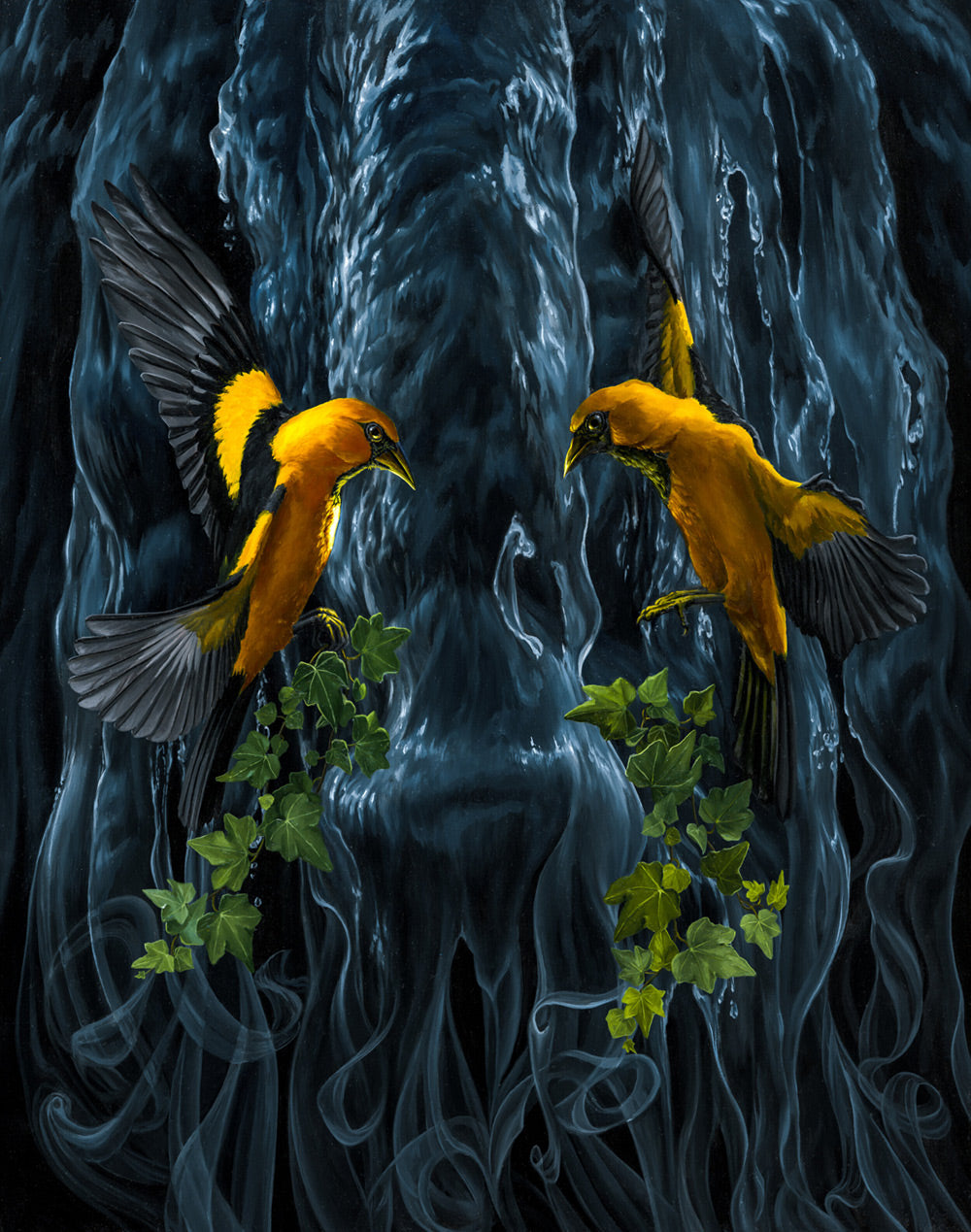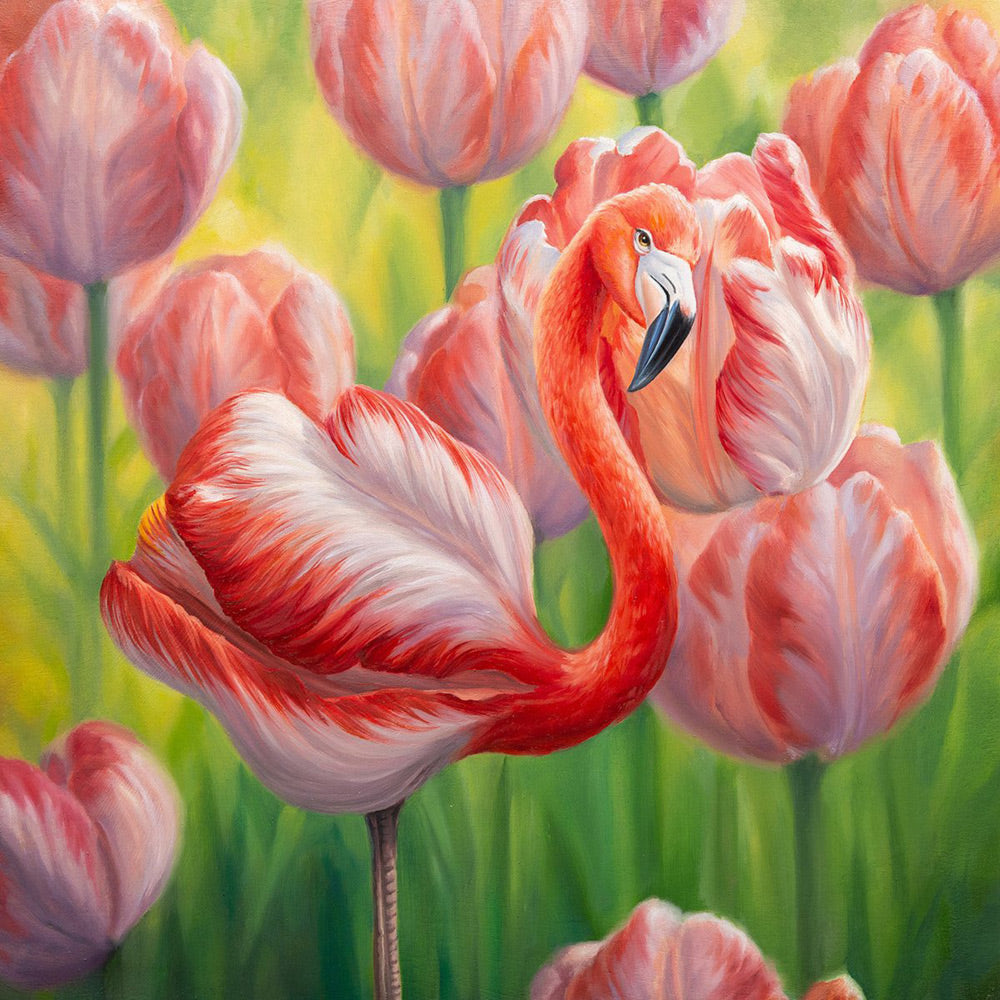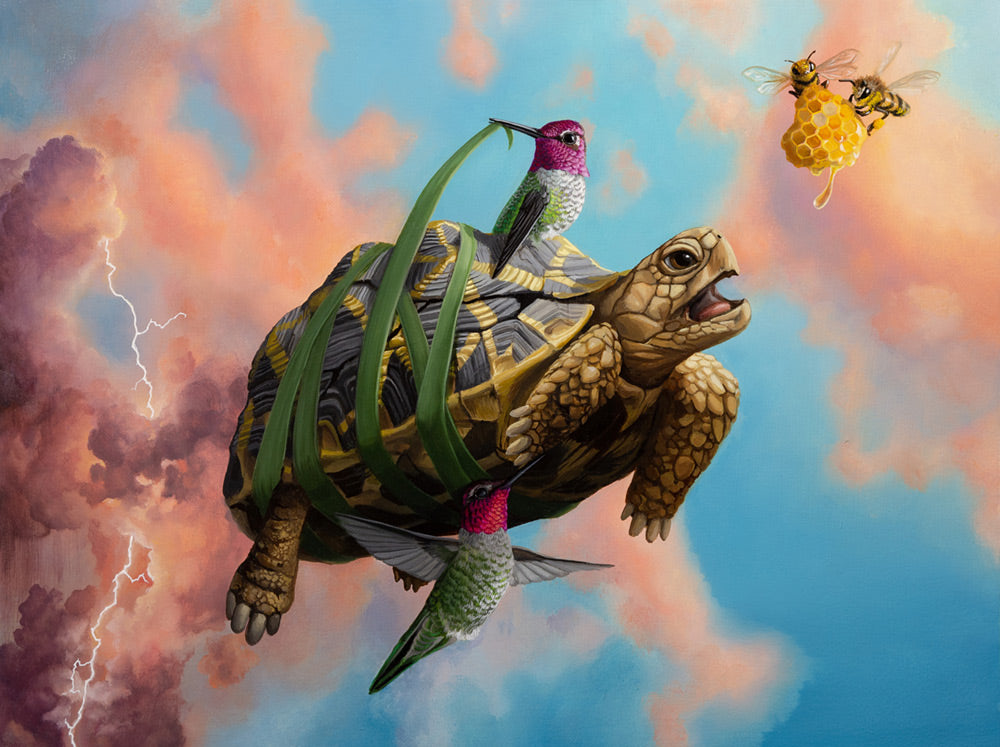
One cannot help but smile at the paintings of Jon Ching. Saturated with colour and often imbued with tenderness, they convey sometimes improbable relationships between flora and fauna. At the core of Ching’s work, though, is a celebration of nature and a quiet, sometimes sly appeal for humans to appreciate the world around them.
Jon Ching’s debut Australian solo exhibition, Phase, will be displayed at the Beinart Gallery from August 8 to August 30. This show started as a contemplation of life on Earth after the impact of humans has ended, but the advent of the COVID-19 pandemic shifted the focus of this series to one more oriented toward transitions in our human life.
Since I started using my work as a means to comment on issues and problems I feel passionately about, I’ve found it necessary to express a silver lining or an aspirational perspective rather than reflect what’s wrong. I dwell a lot on what's wrong, and honestly we’re constantly bombarded with it, so spending the amount of time it takes to make a painting about the negative aspects I see in the world would undoubtedly keep me in a dark place.—Jon Ching

Inoculate - Oil on wood for Jon Ching's solo show, Phase, at Beinart Gallery.
Julie Winters: You have a degree in mechanical engineering, which would seem like one of the ultimately “safe” ways to go about earning a living, but that career never materialised. What led you to pursue that degree, and is there anything from your studies in that arena that carries over into how you approach your art?
Jon Ching: I chose to study engineering exactly for that reason of being a “safe” career path. Toward the end of high school I had passion for and talent in both art and physics, but the purpose of college, in my view at the time, was to start a career. I didn’t know that art could be a career. I didn’t even know art school was a thing, so I chose engineering. I’m glad that I did and had actually tried to work in the alternative energy sector, if only to earn some money for a few years to set me up to pursue art. But I graduated straight into the Great Recession and took the lack of response from engineering as a sign to go for art.
I think the structure of my education gave me the discipline and time management skills necessary to be a working artist. All throughout engineering school they told us that they couldn’t teach us everything but that they would teach us how to teach ourselves. With painting, I’m constantly problem solving and making my process more efficient. My engineering background has helped guide me in that never-ending aspect of being a creator. In history we see that art and science directly complemented each other, and I think they still do.

Homestead - Oil on wood for Jon Ching's solo show, Phase, at Beinart Gallery.
JW: Tell us about how you got your start making art.
JC: My mom, who’s very artistic and crafty, always had some sort of artistic expression and developed in me a love for creation. We’d do things together like making paper, origami, crochet, Chinese calligraphy and crafting holiday gifts for the family. Her encouragement and support have always been the platform for me to express my creativity, and as long as I can remember, I’ve always loved and practised drawing and art making.

Pono - Oil on wood by Jon Ching.
JW: Can you tell us a bit about your process, from the germination of a concept for a painting to how that translates onto the canvas?
JC: In the past, a lot of ideas and concepts came from the muse and I’d gladly accept whatever was given to me. But now, as my production rate has gone up, I’ve had to work a lot more directly on idea development and have taken to a lot of journaling. I have a ‘brain dump’ file where I basically just talk to myself about the theme or idea I’m working on, asking myself questions, arguing with myself and working out the logistics of a piece. This amount of writing is new to me, but I’ve found it very useful to shake loose ideas from the back of my mind. This exercise usually leads to a thread I can follow up with research and sketching. Many times, for one reason or another, this leads to an obstacle or a place for more journaling and I’ll either keep working on it or put it aside for later, if not just chucking it. But in lucky times this develops into a composition strong enough to start a painting. I almost never have the piece fully formed before I start painting, and even sketching is new to me. I work out a fair amount while making the piece because I need to see how elements are working together.

Equanimity - Oil on wood for Jon Ching's solo show, Phase, at Beinart Gallery.
JW: In addition to your oil paintings, your website highlights your photography of musicians as well as of scenes captured internationally. What is it that you look for in taking photographs? How does your eye as a photographer affect your painting, or vice versa?
JC: With photography, especially with live music, I’ve become addicted to anticipating and capturing THE moment. It’s an instant of energy exchange or release, a moment that sums up the character of the performer. In my travels, I’m drawn to unique moments of cultural expression, of a life experience completely different than my own or just the sheer beauty of the land. When composing photographs, like my paintings, I seek out balance and space, giving my subject matter room to fully share their moment while other elements create a balanced harmony. I think photography has been a great way for my eye to practise seeing space, and [as] in painting, has allowed my intuition to tell me where things are needed and where is just right.

Tango - Oil on wood by Jon Ching.
JW: You’ve noted in previous interviews that there is a certain amount of hustle involved in an artist getting their work out into the world: networking with other artists, building connections, visiting galleries, things that can be thought of as marketing. How has our current pandemic situation affected the marketing aspect of your life as an artist? Also, could you share what impact, if any, the pandemic has had on how you make or approach art---whether in terms of subject matter, or if any changes in routine have changed your practice, or anything else that occurs to you in this vein?
JC: The pandemic certainly has had a big impact on my art making, specifically some of the work for my [upcoming] show with Beinart Gallery. It felt like half of my consciousness was always focused on the pandemic—the mass human suffering and loss of life. Even when I didn’t think I was thinking about it, I could feel emotional responses pulsing in waves as I worked. Then the epidemic of police brutality of Black Americans sparked into a pandemic of police brutality of all Americans, compounding the collective anguish of the U.S. and eventually the world. I couldn’t focus on the ideas I had mapped out for the show anymore, and I eventually stopped resisting and responded to those overpowering thoughts and feelings, conceiving and composing new pieces.

Future Ancestor - Oil on wood for Jon Ching's solo show, Phase, at Beinart Gallery.
Since I started using my work as a means to comment on issues and problems I feel passionately about, I’ve found it necessary to express a silver lining or an aspirational perspective rather than reflect what’s wrong. I dwell a lot on what's wrong, and honestly we’re constantly bombarded with it, so spending the amount of time it takes to make a painting about the negative aspects I see in the world would undoubtedly keep me in a dark place. I choose to make work that can spark hope, show compassion or teach lessons that can be a solution. In that way, I feel like I’m physically putting into the world that counterforce, resolution or brighter side.
Regarding how the pandemic has affected the marketing aspects of my art, I’m just thankful for social media and the direct connection I have with my supporters and art friends. I do really miss the physical, social engagement and the natural flow of conversations that always happen at art openings, but I have still been able to occasionally go see and enjoy the work in person. I’m in it for the long game, so this just feels like an extended pause until we can all gather and be friends IRL again.

Tulipa - Oil on wood by Jon Ching.
JW: One of the very fun aspects of your work is how you incorporate features of one life form into another life form; I’m thinking, for example, of the flowers in Tulipa. Is this something that you sort of train your eye for, or is it a gift of pattern recognition or some other thing?
JC: It comes from a mix of both training and proclivity. As a kid, I would tend to see shapes and figures in a lot of things like wood grain, stone marbling, the contours of the mountains. One major concept I’m always trying to express in my work is the interconnectedness of everything. I think that seeing similarities in shapes and patterns across the natural world is a way to explore our connectedness, and once I started looking at things that way, I started to see it everywhere. It doesn’t always come easy, even with my tendencies, and I do a lot of work and observation to find things that mimic or reflect each other to make my ‘flauna’ creatures. It’s a fun exercise of creativity and treasure hunting.

Vital - Oil on wood for Jon Ching's solo show, Phase, at Beinart Gallery.
JW: Looking at the expressions on some of the animals in your paintings, one gets the sense that you feel there is some wisdom they would pass on to us humans if they could. What are your thoughts on our relationship with the natural world?
JC: I think our relationship is broken with the natural world. We’ve stopped seeing it as a life source and something we are a part of and rather regard it as a thing, a resource to use. I believe we are doing the opposite of what our species’ role is in nature. In my opinion we are meant to, with our abilities to understand, organize and predict, help nature thrive, if only as a means to thrive ourselves. But we’ve separated ourselves from nature and no longer can see how we fit in. A lot of us can’t even see that we have an effect on the planet. At some point we stopped behaving like our life depended on the health of our planet and moved to just consuming it.

Cache - Oil on wood for Jon Ching's solo show, Phase, at Beinart Gallery.
I think nature has so much wisdom to teach us. Not just wisdom, but magic. As I continue to learn about indigenous cultures and ways of knowing, I believe we already learned a lot of that wisdom. It hurts me to think that hundreds of thousands of years of developing and transferring that knowledge among our species could be lost in a handful of generations for short-sighted profits that aren’t even needed. I employ my animals and plants to continue this knowledge sharing as I continue to learn.

Kumulipo - Oil on wood by Jon Ching.
JW: When I think of other artists I’ve seen whose work serves as sort of a commentary on the natural world, there are usually still humans depicted in their work, or at least an obvious stamp of the presence of humans. Your pieces are largely devoid of human intervention. Is this absence deliberate, and if so, please tell us more about this decision.
JC: Yes, it is deliberate. I think humans think about and look at humans far too much, especially in modern life with selfies, reality TV and celebrity worship. On top of that, I think we look at and interact with nature too little. So while my art is ultimately about humans and our relationship with nature, I choose to present a world where they don’t or no longer exist, to almost compensate for the overabundance of humancentric images we encounter. On top of that, I find the wonders and beauty of the natural world so much more fascinating than man-made objects, and I’d rather paint and dive into nature details.
To directly contradict myself, I have softened on the subject and have been thinking recently about including some human elements as a means to invite [people] to interact with my paintings more. I think representation is so important, and sometimes I feel like having a human element would help the viewer to see themself and their mark on nature rather than just being an observer. I want to call us to action, and this might be a way.

Reciprocity - Oil on wood by Jon Ching.
JW: From some of your descriptions of your paintings, it’s very clear that you’re not merely an observer of nature but that you’ve done some studying on the subject overall as well. Do you do research for specific paintings, or do your paintings arise out of the knowledge you’ve already garnered?
JC: Often, as a starting point especially for group shows, to see what characters I could employ, I’ll learn about endangered species in the region where the piece will be shown in hopes of engaging the local viewers. This process sparks inspiration as well as providing some parameters to work with. Since I’ve started using animals and the natural world as my subject matter, I’ve been engrossed in learning as much as I can about what I paint. There are endless species and relationships to discover and learn about, which is enjoyable for me and I think adds value to the work. With my desire to help educate others to spark or enforce an affinity with nature, I need to do the learning first myself. And I think realism, with so much observation, is a form of study, so in that way I’m always studying nature.

Pyre - Oil on wood by Jon Ching.
JW: Tell us about your influences: whose work do you admire? What kind of art do you appreciate?
JC: I love and am inspired by so much work out there that this is tough to answer. I definitely tend to be drawn to representational and realist artists, especially ones that focus on the natural world. I love the work of Hannah Yata, Lisa Ericson, Martin Wittfooth, Mark Maggiori, Josie Morway. Non-paint pushers inspiring me right now are Iris Van Herpen, Joel Sartore, Ta-Nahisi Coates, Ellen Jewett, Sasha Velour.

Cradle - Oil on wood for Jon Ching's solo show, Phase, at Beinart Gallery.
JW: You have a solo show coming up at Beinart Gallery in August. Is there anything else on the horizon that you’d like our readers to know about?
JC: I’ll be hunkering down soon to start a new set of paintings for a solo exhibition with Haven Gallery in January 2021. I’m in the early stages, but as a guiding force, I’m going to use the question, ‘How can I make humans worship nature again?’ I don’t exactly know what that will look like, but we need to go back to seeing nature as god, mother, us, again, so that’s my goal.

Moksha - Oil on wood by Jon Ching.
This interview was written by Julie Antolick Winters for Beinart Gallery in July 2020.
Julie Antolick Winters is a writer and editor residing in the state of Maryland, USA, in a small city near Washington, D.C. Julie cowrote the introduction for Black Magick: the Art of Chet Zar and co-copyedited this book and Kris Kuksi: Divination and Delusion for Beinart Publishing. She has also been conducting artist interviews for the Beinart Collective & Gallery since 2010. In addition to her work for the Beinart Gallery, she edits science articles and books, writes poetry and practices the art of negotiation with her son.




 Cart
Cart



